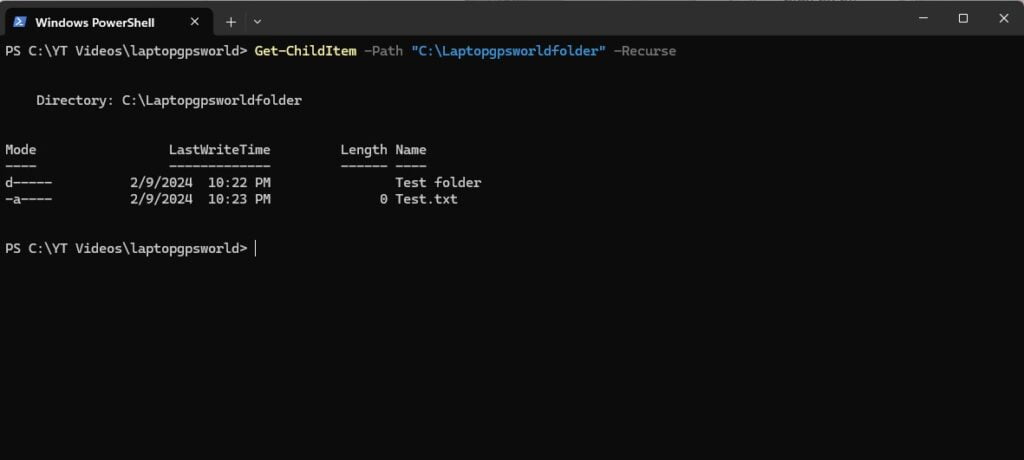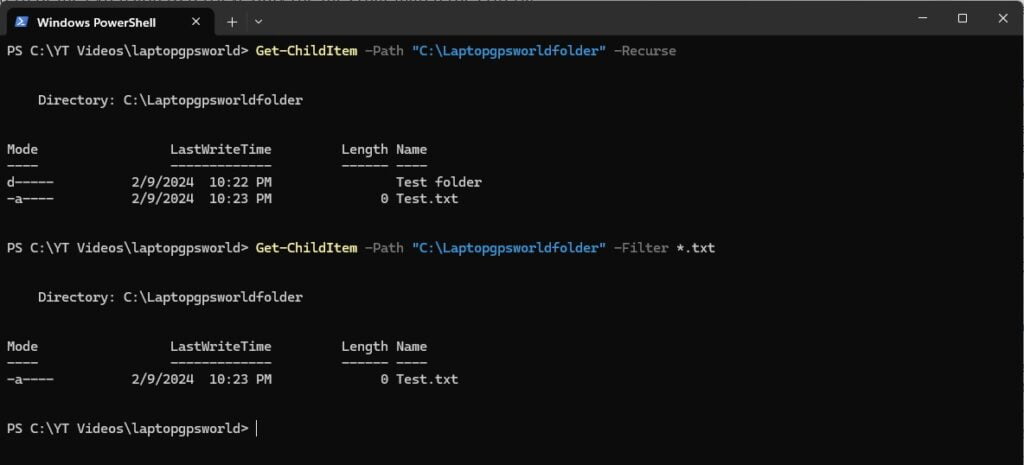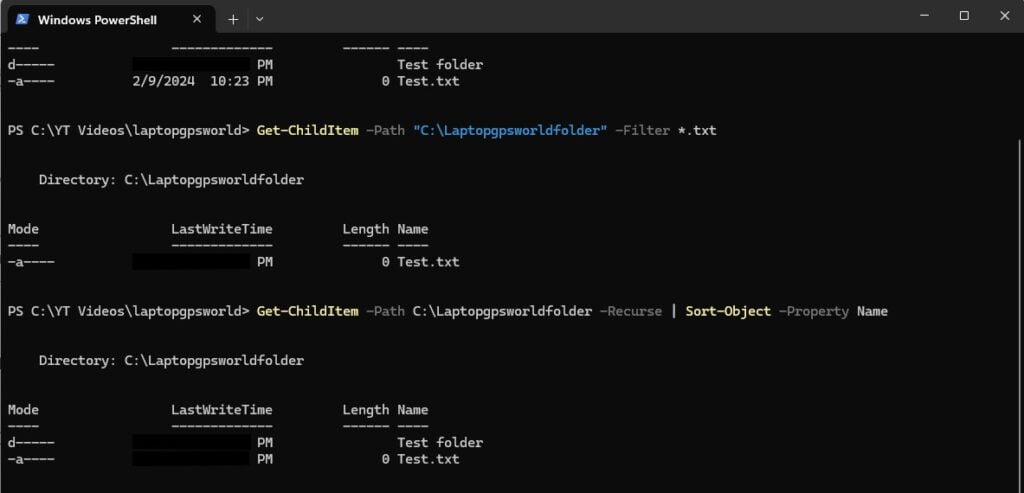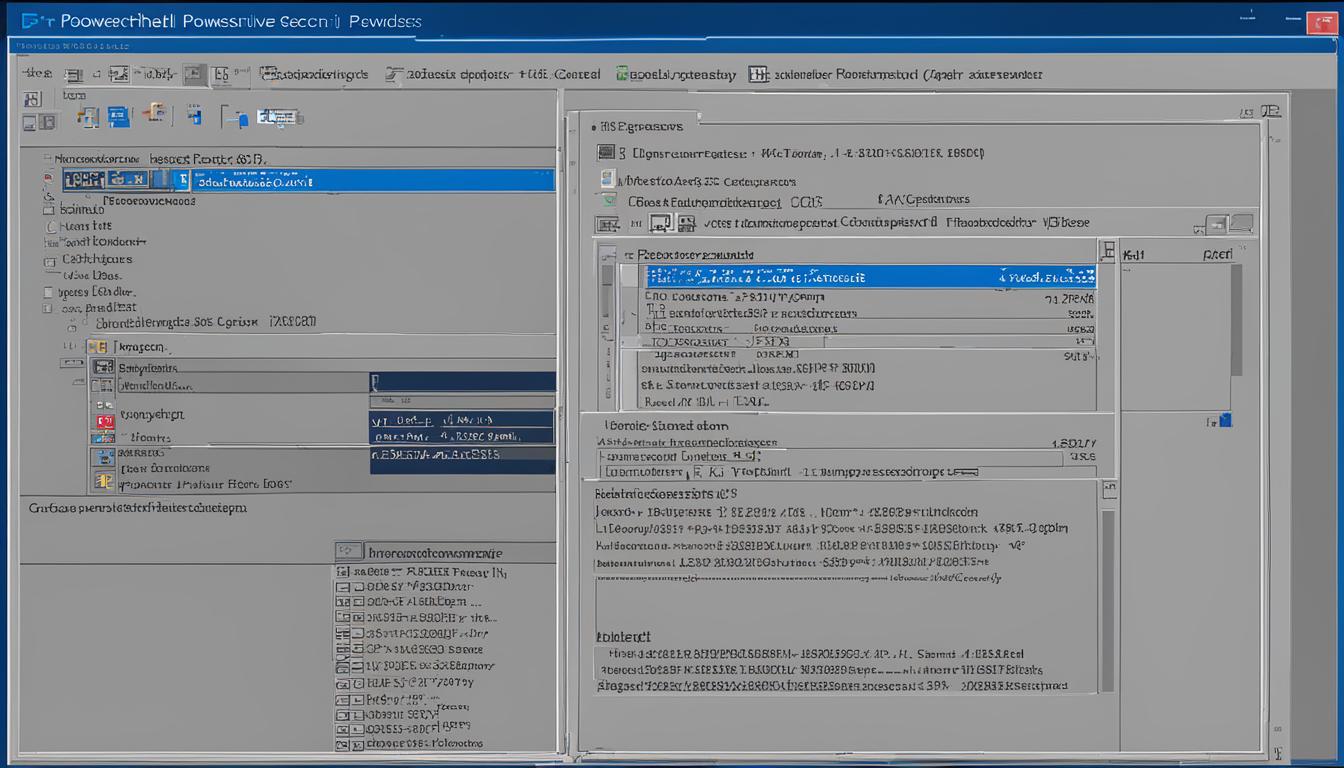Contents
Have you ever wondered how to effortlessly retrieve all files and subfolders from a directory using PowerShell? Look no further! In this article, I will demystify the power of the Get-ChildItem cmdlet with the -Recurse switch. Get ready to take your PowerShell skills to the next level!
Key Takeaways:
- Learn how to use the Get-ChildItem cmdlet to retrieve files and folders recursively
- Discover how to filter, sort, and format the output for analysis and manipulation
- Explore advanced options to customize the retrieval process
- Gain practical examples of using Get-ChildItem in PowerShell scripts
- Enhance your PowerShell scripting skills with efficient file and directory searches
Introduction to Get-ChildItem cmdlet
The Get-ChildItem cmdlet is a fundamental tool in PowerShell for retrieving the contents of directories. This versatile command, similar to the “dir” command in the Windows Command Prompt, allows you to list files and folders in a directory, providing valuable information such as their names, file sizes, and last write times.
By default, Get-ChildItem fetches only the immediate child items from the specified path. However, with the -Recurse switch, you can expand its capabilities to include the entire directory tree, enabling the retrieval of items from all subfolders.
Why Get-ChildItem is essential
Get-ChildItem grants you a comprehensive view and understanding of the file and folder structure within a directory, which is crucial for efficient file management, organization, and analysis. Whether you want to examine the contents of a directory, search for specific files, or perform operations on multiple items, Get-ChildItem is your go-to command.
Let’s explore an example scenario where the power of Get-ChildItem becomes evident.
Example: Listing files and folders recursively
Suppose you have a directory named “Documents” that contains various subfolders representing different projects. Each project folder, in turn, may contain additional subfolders and files. To obtain a comprehensive list of all the files and folders within the “Documents” directory and its subdirectories, you can use the Get-ChildItem cmdlet with the -Recurse switch.
Get-ChildItem -Path C:\Documents -Recurse
This command will retrieve a detailed list of all files and folders within the “Documents” directory, including its subfolders. The retrieved information might include the names of the files and folders, their sizes, and the timestamps of their last write operations.
Using Get-ChildItem with the -Recurse switch allows you to gain a comprehensive overview of the entire directory structure, making it easier to navigate through your files and folders, identify duplicates, analyze usage patterns, and perform further operations as needed.
For a visual representation of the above scenario, refer to the following table:
| Name | Type | Size | Last Write Time |
|---|---|---|---|
| Documents | Folder | – | – |
| Project 1 | Folder | – | – |
| Subfolder 1 | Folder | – | – |
| File 1 | File | 10 KB | 2022-01-01 10:00:00 AM |
| File 2 | File | 5 MB | 2022-01-01 11:30:00 AM |
| Project 2 | Folder | – | – |
| Subfolder 1 | Folder | – | – |
| File 1 | File | 2 KB | 2022-01-02 09:00:00 AM |
| File 2 | File | 1 MB | 2022-01-02 10:30:00 AM |
As you can see, by using Get-ChildItem with the -Recurse switch, you can obtain a comprehensive and structured list of all the files and folders, providing a clear overview of the hierarchical structure and the associated file attributes.
In the next section, we will explore how to utilize the -Filter and -Exclude parameters to filter and refine the results obtained with Get-ChildItem, further enhancing its functionality and relevancy for specific tasks.
Using Get-ChildItem with the -Recurse switch
When working with PowerShell, the Get-ChildItem cmdlet offers powerful capabilities for listing files and folders in a directory. By incorporating the -Recurse switch, you can extend its functionality to recursively retrieve all files and subfolders from a specified path.
To utilize the -Recurse switch, simply append it to your command. For example:
Get-ChildItem -Path C:\Files -Recurse

This command would retrieve all files and subfolders from the “C:\Files” directory and its subdirectories.
Using the -Recurse switch is particularly efficient when you need to search through a deep directory structure or perform operations on all files and subfolders within a directory tree. It saves you the effort of manually traversing each subfolder and enables you to retrieve the desired items in one go. This can greatly simplify tasks such as data analysis, backup operations, or content management.
Example:
Let’s say you have a directory structure like this:
C:\Files
├── Documents
│ ├── Report.docx
│ └── Resume.pdf
└── Pictures
├── Nature
│ ├── Scenery.jpg
│ └── Wildlife.jpg
└── Vacation
├── Beach.jpg
└── Mountain.jpg
To retrieve all files and subfolders from the “C:\Files” directory and its subdirectories, you can use the following command:
Get-ChildItem -Path C:\Files -Recurse
The output will be:
| Name | FullName | Extension | Length | LastWriteTime |
|---|---|---|---|---|
| Report.docx | C:\Files\Documents\Report.docx | .docx | 10240 | 24/07/2022 10:45 AM |
| Resume.pdf | C:\Files\Documents\Resume.pdf | 5120 | 24/07/2022 09:30 AM | |
| Scenery.jpg | C:\Files\Pictures\Nature\Scenery.jpg | .jpg | 20480 | 23/07/2022 02:15 PM |
| Wildlife.jpg | C:\Files\Pictures\Nature\Wildlife.jpg | .jpg | 25600 | 23/07/2022 04:20 PM |
| Beach.jpg | C:\Files\Pictures\Vacation\Beach.jpg | .jpg | 40960 | 22/07/2022 11:10 AM |
| Mountain.jpg | C:\Files\Pictures\Vacation\Mountain.jpg | .jpg | 30720 | 22/07/2022 01:30 PM |
This table represents the retrieved files and subfolders along with their respective attributes such as name, full path, file extension, size, and last write time. As you can see, the -Recurse switch enabled us to retrieve all the items within the directory tree, making it easier to manage and analyze the collected data.
In the next section, we will explore different ways to filter the results obtained with Get-ChildItem to extract specific files or customize the output.
Filtering results with Get-ChildItem
Get-ChildItem provides powerful options for filtering the results, allowing you to search for specific files in subfolders and directories recursively. By using the -Filter parameter, you can specify a pattern or file extension to retrieve only the files that match the criteria.
For example, let’s say you want to search for all the text files within the “C:\Files” directory and its subdirectories. You can use the following command:
Get-ChildItem -Path C:\Files -Filter *.txt
By executing this command, you will retrieve only the text files from the specified directory and its subfolders. This filter parameter allows you to narrow down your search and retrieve only the files that match the specified criteria.
In addition to the -Filter parameter, you can also use the -Exclude parameter to exclude specific items based on their names or patterns. This can be helpful if you want to filter out certain files or folders from your search results.
Filtering your results with Get-ChildItem gives you the flexibility to search for specific files within subdirectories and directories recursively. This ability to refine your search results is valuable when dealing with large file structures and allows you to locate the files you need more efficiently.
Sorting and formatting the output
When working with the Get-ChildItem cmdlet in PowerShell to retrieve all files and folders recursively, it’s important to have the ability to sort and format the output according to your preferences. Luckily, PowerShell provides several handy tools for accomplishing this.
Sorting the Output: To sort the results based on a specific property, such as Name or LastWriteTime, you can use the Sort-Object cmdlet. For example, if you want to sort the files and folders alphabetically by name, you can use the following code:
Get-ChildItem -Path C:\Files -Recurse | Sort-Object -Property Name
This will return a sorted list of all the files and folders in the specified directory and its subdirectories.
Formatting the Output: Formatting the output as a table can make it easier to analyze and manipulate the retrieved files and folders. PowerShell’s Format-Table cmdlet allows you to do just that. With Format-Table, you can specify specific columns you want to display and customize the output to suit your needs.
To format the output as a table with specific columns, use the following code:
Get-ChildItem -Path C:\Files -Recurse | Format-Table Name, LastWriteTime, Length
This will display a table with the Name, LastWriteTime, and Length columns for all the files and folders in the specified directory and its subdirectories.
By combining the capabilities of sorting and formatting the output with the Get-ChildItem cmdlet, you can easily analyze and work with the retrieved files and folders in a way that best suits your needs.
Check out the example below to see it in action:
| Name | Last Write Time | Size |
|---|---|---|
| file1.txt | 2021-01-01 10:00:00 AM | 1.5 KB |
| file2.jpg | 2021-01-02 02:30:00 PM | 5.2 MB |
| folder1 | 2021-01-03 09:45:00 AM | – |
| file3.docx | 2021-01-04 03:15:00 PM | 512 KB |
Practical examples of using Get-ChildItem
Now that we have an understanding of how the Get-ChildItem cmdlet works and its various options, let’s explore some practical examples of using it in PowerShell scripts. These examples will showcase how Get-ChildItem can be used for recursive file and folder searches, allowing you to efficiently navigate and manipulate your directory structures.
Example 1: Recursive File Search
If you need to search for files with a specific extension in a directory and all its subdirectories, you can use the following script:
Get-ChildItem -Path C:\Documents -Recurse -Filter *.txtThis script will retrieve all the text files (.txt) in the “C:\Documents” directory and its subdirectories.
Example 2: Recursive Folder Search
If you want to search for folders with a certain name in a directory and all its subdirectories, you can use this script:
Get-ChildItem -Path C:\Projects -Recurse -Directory -Filter "Archive"This script will retrieve all the folders named “Archive” in the “C:\Projects” directory and its subdirectories.
These examples demonstrate how Get-ChildItem can be used to perform powerful and efficient recursive searches in PowerShell. Whether you need to search for specific file types or locate particular folders, Get-ChildItem provides the flexibility and functionality to streamline your operations.
| Example | Description |
|---|---|
| Example 1 | Recursive File Search |
| Example 2 | Recursive Folder Search |
Advanced options with Get-ChildItem
Get-ChildItem offers advanced options that give you the ability to customize its behavior and focus on specific items of interest. By leveraging these options, you can enhance your file and folder retrieval process. Let’s explore two key features in depth: the -Depth parameter and the -Hidden, -ReadOnly, and -System parameters.
Limiting retrieval depth with -Depth parameter
The -Depth parameter allows you to control the depth of retrieval when using Get-ChildItem. By specifying a number, you can limit the levels of recursion, ensuring that the search only goes as deep as you desire. This is especially useful when dealing with large directory structures where you want to narrow down the search scope. For example:
Get-ChildItem -Path C:\Files -Recurse -Depth 2This command retrieves files and subfolders from the “C:\Files” directory, restricting the search to a maximum depth of two levels. This way, you can avoid retrieving files and subfolders that are too deep in the directory structure.
The -Hidden, -ReadOnly, and -System parameters allow you to specify certain types of files or folders you want to retrieve with Get-ChildItem.
The -Hidden parameter retrieves hidden files and folders that are typically not visible in the directory listing. This is useful when you need to work with sensitive files or handle system-related items.
The -ReadOnly parameter retrieves files and folders that have the read-only attribute set. This can be helpful when you want to perform operations based on the read-only status of items.
The -System parameter retrieves system files and folders, which are essential for the operating system’s functioning. This option allows you to work specifically with these critical components.
For example:
Get-ChildItem -Path C:\Files -Hidden -ReadOnly -SystemThis command retrieves hidden, read-only, and system files and folders from the “C:\Files” directory and its subdirectories. You can combine these parameters as needed to retrieve specific types of items.
By utilizing the -Depth parameter and the -Hidden, -ReadOnly, and -System parameters, you can refine your Get-ChildItem queries and retrieve the precise files and folders you require.
Conclusion
In conclusion, the Get-ChildItem cmdlet in PowerShell is an incredibly useful tool for effortlessly listing files and folders within a directory. By leveraging the power of the -Recurse switch, you can efficiently retrieve all files and subfolders from your desired path. Additionally, Get-ChildItem offers a range of options to filter, sort, and format the output, allowing for seamless analysis and manipulation of the retrieved items. The advanced options further enhance control over the retrieval process, enabling you to focus on specific items of interest.
Mastering Get-ChildItem will significantly enhance your PowerShell scripting skills and empower you to perform efficient file and directory searches. With its versatility and extensive capabilities, Get-ChildItem is an indispensable asset for any PowerShell user. Whether you’re a beginner or an experienced scripter, incorporating Get-ChildItem into your workflow will undoubtedly streamline your file management and exploration tasks. By harnessing the power of PowerShell’s Get-ChildItem cmdlet, you can unlock a world of possibilities and take your scripting abilities to new heights.
With its ability to effortlessly list files and folders, the Get-ChildItem cmdlet in PowerShell provides an excellent foundation for various automation and data analysis tasks. Whether you’re searching for specific files, analyzing a directory structure, or performing bulk operations, Get-ChildItem empowers you with comprehensive control over the retrieval process. By mastering the usage of Get-ChildItem with the -Recurse switch and familiarizing yourself with its advanced options, you’ll have the necessary skills to efficiently navigate the complexities of file systems and extract valuable insights from your data. Upgrade your PowerShell capabilities with Get-ChildItem and discover the power of this indispensable tool in your scripting endeavors.
